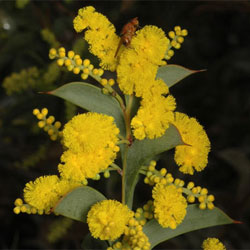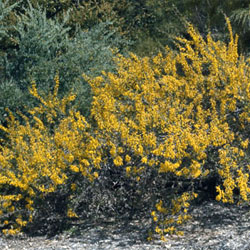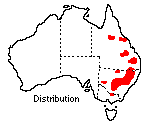Acacia triptera
 |
 |
Spur-wing Wattle
Spur-wing Wattle (Acacia triptera) occurs in New South Wales and Queensland on sandstone and gravel ridges, and in Victoria is a rare plant confined to granite rocks in the Warby Ranges. It is a rigid dry-country shrub, upright or low and spreading, 1-3 m high.
This is a beautiful lesser-known Wattle with long curving branches and stiff curved leaves which are very even and blue-green in a thriving plant. Each leaf tapers to a sharp spine, and the species is distinguished for its broadened leaf base running down the stem giving a winged effect
 The
entire plant is smooth and hairless. Foliage is of the type known as phyllodes
and is often found in Wattles of dry or hot regions. A phyllode is a flattened
leaf stalk which has probably evolved as a means of conserving moisture in dry
areas. It is more efficient in this regard than the feathery, pinnate leaf usually
found on Acacias from wetter areas.
The
entire plant is smooth and hairless. Foliage is of the type known as phyllodes
and is often found in Wattles of dry or hot regions. A phyllode is a flattened
leaf stalk which has probably evolved as a means of conserving moisture in dry
areas. It is more efficient in this regard than the feathery, pinnate leaf usually
found on Acacias from wetter areas.
Phyllodes are generally thicker, joining the stems firmly,with edges facing the sun. They show a great range of shapes and sizes - flat and broad, narrow, needle-like, small spines, triangular and always undivided. Some resemble Eucalypt leaves, but as they have no scent when bruised they are easily recognised as Acacias.
Phyllodes look and act like leaves-the term is from Greek words meaning like a leaf-but their function is not fully understood botanically. For the gardener, however, they give a wide choice in ornamental foliage which tends to be strong and unblemished. In the open, with deep light soil, weeded and watered, an isolated shrub is fairly heavy and spreads about 5 m along the ground. The form is dense and shapely with long curving branches in various directions, rising to 1.5 m high. Older, rough branches are 6 cm diameter at ground level, and before a plant reaches this size some trimming may be advisable to avoid splitting at the centre.
In shallower soil, in shade or with some competition and when receiving less moisture, a more lightweight shrub develops. It is likely to be upright and open, with thin branches weeping or curving gracefully. Young plants in the Australian National Botanic Gardens flowered first when 70 cm high and two years old from late October to mid-November. Watering was essential until plants were established, and later fairly dry to wet conditions have been tolerated. No frost damage has been recorded and plants appear toneed no protection in winter. Like other Wattles, buds form months before flowering; in this case they are coppery and can be described as seasonal tints as they alter the general appearance of the shrub. Flower spikes are up to 2.5 cm long, one or two to each phyllode well down the stems. For about three weeks in spring the shrubs are a mass of soft, rich yellow flowers.
Based on text by ANBG staff (1973)
Name meaning: Acacia tripteraAcacia - thought to be from a Greek word meaning to sharpen in reference to prickly species first discovered, or it may refer to the Egyptian Thorn (akakia) which yields gum; triptera - three-winged, intending to describe the leaf bases on the stems, like wings |
![An Australian Government Initiative [logo]](/images/austgovt_brown_90px.gif)

